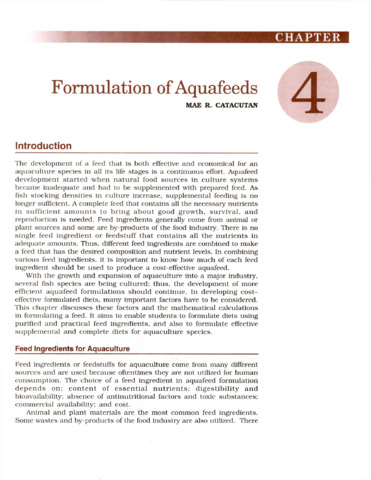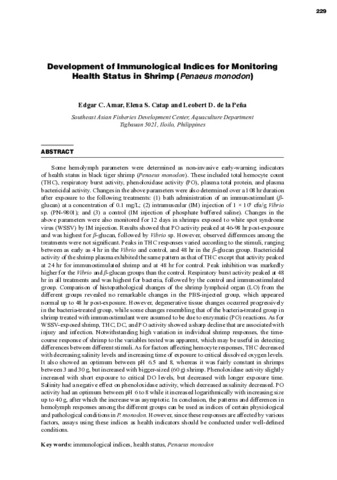Nutritional evaluation of mysids Mesopodopsis orientalis (Crustacea:Mysida) as live food for grouper Epinephelus fuscoguttatus larvae
| dc.contributor.author | Eusebio, P. S. | |
| dc.contributor.author | Coloso, R. M. | |
| dc.contributor.author | Gapasin, R. S. J. | |
| dc.date.accessioned | 2014-09-08T07:44:48Z | |
| dc.date.available | 2014-09-08T07:44:48Z | |
| dc.date.issued | 2010 | |
| dc.identifier.citation | Eusebio, P. S., Coloso, R. M., & Gapasin, R. S. J. (2010). Nutritional evaluation of mysids Mesopodopsis orientalis (Crustacea:Mysida) as live food for grouper Epinephelus fuscoguttatus larvae. Aquaculture, 306(1-4), 289-294. | en |
| dc.identifier.issn | 0044-8486 | |
| dc.identifier.uri | http://hdl.handle.net/10862/2131 | |
| dc.description.abstract | The potential of mysids Mesopodopsis orientalis as live food source for grouper Epinephelus fuscoguttatus larvae was investigated. In comparison with Artemia biomass, a common live food source in larviculture, mysids contained significantly higher levels of protein, total lipid, eicosapentaenoic acid (EPA, C20:5n−3), and docosahexaenoic acid (DHA, C22:6n−3). DHA was not detected in Artemia biomass. Grouper larvae fed mysids from 35 to 55 days after hatching (DAH) had 2-fold and 3-fold higher specific growth rates and survival, respectively, than those fed Artemia biomass. DHA levels increased 6-fold while EPA levels remained constant in mysid-fed grouper larvae. In contrast, DHA and EPA significantly decreased in Artemia biomass-fed grouper larvae. Furthermore, the specific activities of amylase, lipase and protease generally significantly increased (P< 0.05) in both mysid-fed and Artemia biomass-fed grouper larvae from 35 to 55DAH. A marked increase in the specific activity of amylase was seen in mysid-fed than in Artemia biomass-fed grouper larvae. Results of the nutritional evaluation suggest that mysids are superior live food organisms than Artemia biomass for grouper larvae and could significantly improve production of grouper juveniles in the nursery phase. | en |
| dc.description.sponsorship | The authors express their appreciation and thanks to Zenith Gaye Orozco for technical assistance, Joseph Biñas for the assistance in statistical analysis of the data and preparation of the manuscript, Gwen Anuevo of the Laboratory Facilities for Advanced Aquaculture Technology, SEAFDEC/AQD for proximate analysis, and Irene Cabanilla of SEAFDEC/AQD Finfish Hatchery. We also thank Dr. Yukio Hanamura of Japan International Research Center for Agricultural Sciences, Tsukuba, Japan for species identification of mysids. | en |
| dc.language.iso | en | en |
| dc.publisher | Elsevier | en |
| dc.subject | Artemia | en |
| dc.subject | Digestive enzymes | en |
| dc.subject | essential fatty acids | en |
| dc.subject | groupers | en |
| dc.subject | Nutritional evaluation | en |
| dc.title | Nutritional evaluation of mysids Mesopodopsis orientalis (Crustacea:Mysida) as live food for grouper Epinephelus fuscoguttatus larvae | en |
| dc.type | Article | en |
| dc.identifier.doi | 10.1016/j.aquaculture.2010.05.004 | |
| dc.citation.volume | 306 | |
| dc.citation.issue | 1-4 | |
| dc.citation.spage | 289 | |
| dc.citation.epage | 294 | |
| dc.citation.journalTitle | Aquaculture | en |
| seafdecaqd.databank.controlnumber | 2010- | |
| dc.subject.asfa | aquaculture | en |
| dc.subject.asfa | diet | en |
| dc.subject.asfa | feed composition | en |
| dc.subject.asfa | feeding experiments | en |
| dc.subject.asfa | fish larvae | en |
| dc.subject.asfa | cultured organisms | en |
| dc.subject.asfa | marine fish | en |
| dc.subject.asfa | nutrition | en |
| dc.subject.asfa | nutritional requirements | en |
| dc.subject.scientificName | Epinephelus fuscoguttatus | en |
| dc.subject.scientificName | Mesopodopsis orientalis | en |
Files in this item
| Files | ขนาด | รูป | View |
|---|---|---|---|
|
There are no files associated with this item. |
|||
รายการนี้ปรากฏใน (s)
-
Journal Articles [1256]
These papers were contributed by Department staff to various national and international journals.




